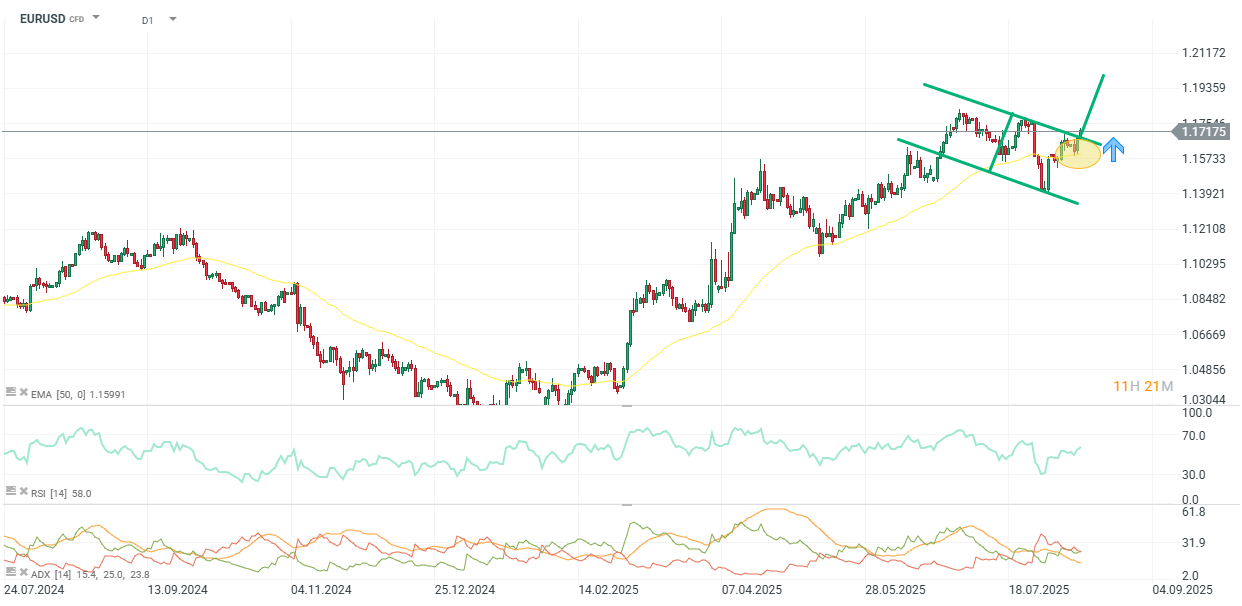Since the beginning of 2025, the euro has been one of the best-performing currencies, along with the Swiss franc, while the dollar became the scapegoat for the US president's policies, having its worst first half of the year since 1973. What factors could move the currency market in the coming days?
US Inflation Data
The euro reached its highest level in the last two weeks against the dollar. This rise is partly due to lower-than-expected inflation in the US. Such data usually pressures the Federal Reserve to lower interest rates, weakening the dollar.
The data confirmed market expectations that the Federal Reserve will resume interest rate cuts in September, causing the dollar to fall. The market currently prices in a 96% probability that the Fed will cut rates by 25 basis points, but rumors of a 50 basis point cut are gaining more and more support.
The expectation of rate cuts in September is supported not only by inflation data but also by statements from key figures. For example, Treasury Secretary Scott Bessent has argued that the Fed should make another jumbo rate cut of 50 basis points in September, as it did last year.
Trump's Attacks
President Trump's attacks on the Federal Reserve and the U.S. Bureau of Labor Statistics pose a threat to the dollar's outlook. On Tuesday, Trump reiterated his criticism of Federal Reserve Chairman Jerome Powell for failing to cut interest rates.
Trump also threatened to sue Powell over renovations at the Federal Reserve headquarters in Washington, which have exceeded the initially agreed-upon budget.
On Monday, Trump nominated conservative think tank economist EJ Antoni to replace the director of the BLS, whom he fired earlier this month after the release of jobs data, which increasingly evokes autocratic countries, where the heads of statistical agencies or central banks are replaced.
These moves increasingly call into question the independence of both agencies, damaging the US's image worldwide and weakening the attractiveness of its currency.
Adding to the political uncertainty in the US is geopolitics in Europe. And here comes a factor that has historically weighed negatively on the euro: the conflict in Ukraine.
Possible peace in Ukraine
The euro's potential gains against the dollar could be limited until after Friday's meeting between President Trump and Russian President Vladimir Putin.
It's worth remembering that the euro weakened significantly in the months following the start of the war in Ukraine, falling from around 1.14 against the dollar at the beginning of 2022 to parity in July, and reaching a low of around 0.96 in September, representing a 16% drop in the eurozone.
The market anticipated a greater risk of recession in the eurozone than in the US, due to the dependence on gas from Russia, and the ECB taking longer to raise interest rates to combat inflation, which explained part of the movement in both currencies.
Analysis
As long as it remains above 1.16, levels coinciding with the 50-session moving average and key support, the bias is bullish. The exchange rate has been in a strong upward trend this year. In recent days, it has formed a continuation pattern known as a flag, and a breakout of it offers short-term potential to 1.20. The RSI is at 58, which does not yet offer overbought signals, while ADX around 25 indicates a developing trend, not weak, but with room to strengthen.

Conclusion
Anticipating a baseline scenario in which the Fed will begin cutting interest rates in September, with a weak labor market, and with Trump as the undisputed market leader, we believe the dollar will continue its downward trend over the coming months.
If peace in Ukraine progresses and the European economy shows signs of recovery, the euro could gradually move toward levels of 1.20–1.25 against the dollar, although this path would not be without its ups and downs.
Daily Summary: Wall Street ends the week with a calm gain 🗽 Cryptocurrencies slide
BREAKING: US PCE inflation in line with expectations 🔎UoM prelim data slightly higher
BREAKING: Lower Unemployment in Canada🍁USDCAD sharply declines📉
DE40: Adequate data, Mild growth
The content of this report has been created by XTB S.A., with its registered office in Warsaw, at Prosta 67, 00-838 Warsaw, Poland, (KRS number 0000217580) and supervised by Polish Supervision Authority ( No. DDM-M-4021-57-1/2005). This material is a marketing communication within the meaning of Art. 24 (3) of Directive 2014/65/EU of the European Parliament and of the Council of 15 May 2014 on markets in financial instruments and amending Directive 2002/92/EC and Directive 2011/61/EU (MiFID II). Marketing communication is not an investment recommendation or information recommending or suggesting an investment strategy within the meaning of Regulation (EU) No 596/2014 of the European Parliament and of the Council of 16 April 2014 on market abuse (market abuse regulation) and repealing Directive 2003/6/EC of the European Parliament and of the Council and Commission Directives 2003/124/EC, 2003/125/EC and 2004/72/EC and Commission Delegated Regulation (EU) 2016/958 of 9 March 2016 supplementing Regulation (EU) No 596/2014 of the European Parliament and of the Council with regard to regulatory technical standards for the technical arrangements for objective presentation of investment recommendations or other information recommending or suggesting an investment strategy and for disclosure of particular interests or indications of conflicts of interest or any other advice, including in the area of investment advisory, within the meaning of the Trading in Financial Instruments Act of 29 July 2005 (i.e. Journal of Laws 2019, item 875, as amended). The marketing communication is prepared with the highest diligence, objectivity, presents the facts known to the author on the date of preparation and is devoid of any evaluation elements. The marketing communication is prepared without considering the client’s needs, his individual financial situation and does not present any investment strategy in any way. The marketing communication does not constitute an offer of sale, offering, subscription, invitation to purchase, advertisement or promotion of any financial instruments. XTB S.A. is not liable for any client’s actions or omissions, in particular for the acquisition or disposal of financial instruments, undertaken on the basis of the information contained in this marketing communication. In the event that the marketing communication contains any information about any results regarding the financial instruments indicated therein, these do not constitute any guarantee or forecast regarding the future results.


